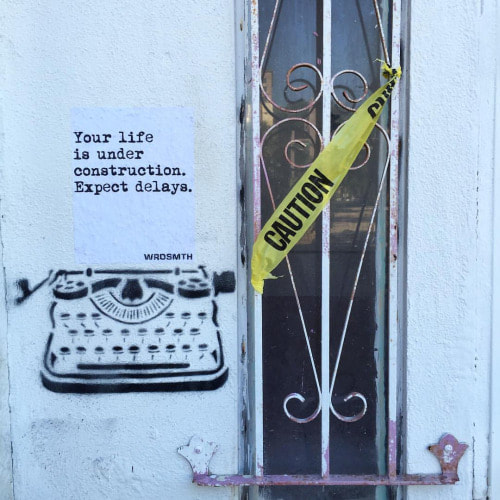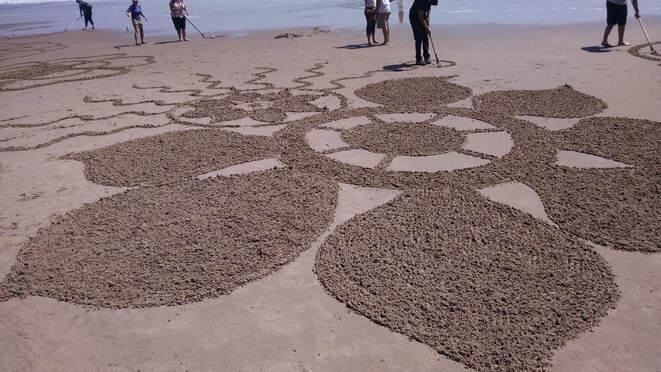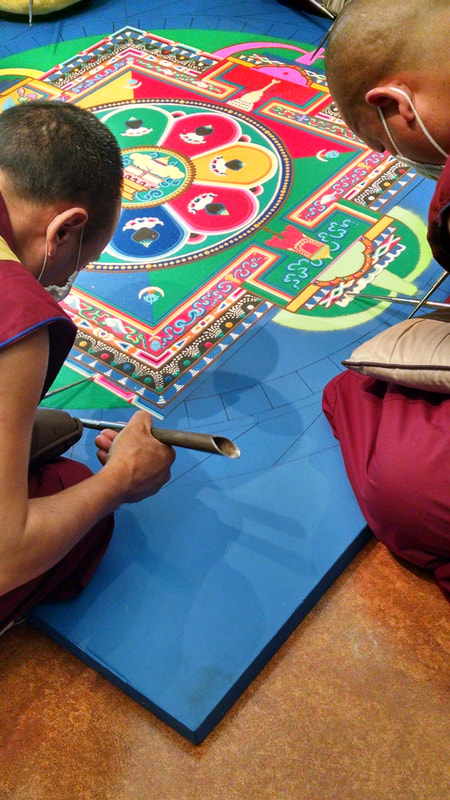|
By its most elemental definition, that which is ephemeral is that which does not last. Traditionally, art has been viewed as a medium that goes against the idea of impermanent. Art is meant to be passed down to future generations. Art is meant to hang in museums for hundreds of years. Or is it? It’s fair to say that most artists would trade their lucky paintbrush for a chance to hang in MOMA, under constant threat of being stolen by Pierce Brosnan. But is how an oil painting looks on a gallery wall the only measure of what makes art art? Let’s look at the two points of view of art: The artist and the observer. An artist wants to create something beautiful or provocative and to have it seen by others. An observer wants to see something beautiful or provocative that they did not create themselves. Pretty simple, right? Now let’s remove the parameter of durability from the equation. The artist can now create a piece, walk away, and leave it to live a life of its own. However long that life may be, it will not be stagnant. This can be a scary proposition or a liberating one. An observer of art that exists out in the wild is suddenly put in the position explorer and discoverer. They have not been herded into a well-lit room and told what pieces of paper and ink qualify as good art by experienced curators. Out on the streets they can be surprised by art and walk away knowing that they may be only one of a handful of people who will ever get to see that piece. In the end, it’s the transitory nature of impermanent art that makes it so intriguing, no matter what side of the lens you’re on. Each of us is capable of hitting the pavement, eyes peeled, to seek out this type of art, but not all of us are capable of leaving our own mark. So we sat down with three artists who specialize in the art of ephemerality. WRDSMTH Los Angeles street artist WRDSMTH is a favorite of Southern California Instagrammers. His sweet, funny, and inspiring messages can be found on walls and stationary objects all over the city (as well as cities around the world) on large sheets of paper carefully affixed with wheatpaste over his signature typewriter stencil. These “temporary tattoos” or “WRDS”, as he calls them, are like surprise art bombs for those that find them. How do you prepare yourself to create a piece knowing that it might not physically last? What is that creative process like? The impermanence of my art is part of what I do. While it doesn't make me happy, I have come to accept it. I aim to put up art in both highly visible locations and locations where I feel the pieces might last a little longer. The latter might be spots in alleys or walls that tucked around less-traveled corners where people might stumble upon or have to seek out the actual location. Also, a big part of what I do is placing pieces where my WRDs are paid off by the location or what's next to or behind the piece. I am constantly driving around and walking around areas looking for great locations to accomplish that. How do you feel when you're in the moment of creating? There's always an adrenaline rush and a great thrill in putting up a piece. Part of that is simply creating and part of that is the fact that what street artists do is technically not legal. While the latter isn't a great situation, again, it is just a part of the action of doing street art. Does it ever bother you that your work disappears? It does. While I wish the pieces would last forever and even be somehow preserved, I know that the impermanence of street art actually romanticizes the action. It's frustrating for every artist, but there is also something great about the here today/gone tomorrow aspect of what we do. As a street artist, I think you just have to come to accept it and carry-on. And if it is/was a really great location that ended up getting painted over or buffed, you can always hit it again with a new piece of art. I often do that. How do you hope people will react when they come across your finished pieces? What do you hope to convey? I do three types of WRDs -- inspirational/motivational, romantic, and funny ones. I think I'm funny. Any piece I put up, I do with the hope that it resonates with people and either motivates them or simply makes them smile. Bottom line, I aim to affect people in a positive manner. ANDRES AMADOR Andres Amador is a San Francisco-based artist that has been making sand art since 2004. No, he’s not building sandcastles. His uses a rake and a smooth, damp coastline to create pieces that can span over 100,000 feet in length. Because his canvas is the beach, his work will often disappear within minutes of creation as the tide comes back in. In these moments, Andres reflects on nature of impermanence and the reminder “that the joyous creation is its own reward”. How do you prepare yourself to create a piece that you know will not physically last? What is that creative process like? I make sure I have my camera! I don't feel I need preparation for the fact that my art will dissolve very quickly. But there are times when the elements aren't aligning well. These are the times when I remind myself of the transient nature of my work, nature, and really, life itself. The creative process is one of allowing a design to bubble up and go through its process of development. Does it ever bother you that your work disappears? Something big that comes with this art is the recognition of impermanence. I create with the knowledge of the impending erasure of my efforts, often while I am working. It has turned the art form into a practice of process over product. I am always striving for the perfect photo that I can share proudly. But when I get to the beach I have already let go of that expectation and surrender to the act of creation. (bio) How do you hope people will react when they come across your finished pieces? What do you hope to convey? [My] ultimate desire with displaying the art work is to bring a sense of wonder and immediacy to the viewer. (bio) MONKS OF THE DREPUNG GOMANG MONASTERY As part of their annual Tibetan Sacred Art Tour, the monks of the Drepung Gomang Monastery of Mungrod, South India travel around the United States creating intricately detailed sand mandalas. Each stop on the tour lasts several days and includes daily prayer and opening and closing ceremonies, the latter of which involves the destruction of the mandala that it took hundreds of hours to create.
The Drepung Gomang monks are renowned for the sacred art of sand mandala construction. Artist, instructor, and director of the Foxworthy Gallery, Marti Fast, acts as ambassador and host when they visit Allan Hancock College. What is the process of creating this type of art like? The monks use long metal funnels called chak-purs to lay down millions of grains of very fine, colored sand onto a design they’ve sketched out onto a large, flat platform. And you can see how dimensional it is and how consistently even. It’s like looking at a whole other world. Does it bother the monks that their work will be destroyed? It’s such an unusual art form in that destruction is actually part of the process. There is wonderful intention behind it. They know that life can change suddenly. It’s about accepting that in nature and life you can’t keep things the same. After the destruction ceremony, the sand is put into a moving body of water to spread that positive energy out. What do they hope to convey to those that witness the creation of the mandala? There’s a very relaxing presence in the gallery. It’s a calm place to breathe and be in peace. People feel at peace just watching the process. The making of the art, and the witnessing of the art, is a total focus on the present moment. We have the ability to focus fully on the moment. It’s meditative. It’s really about channeling a positive energy out into the world.
1 Comment
|
Appreciate the Arts
Art is life and life is adventure and adventure is art. Archives
November 2018
Categories |



 RSS Feed
RSS Feed
